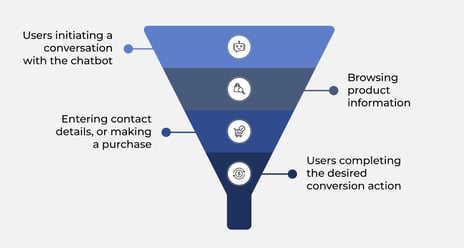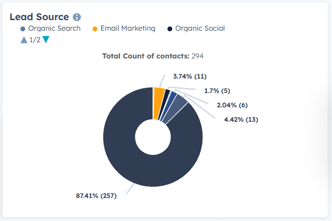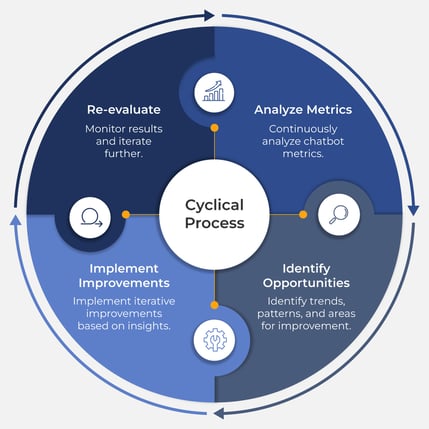Table of Content
TABLE OF CONTENTS
Chatbots - maximizing efficiency and customer satisfaction
Chatbots have become an undeniable force in the digital landscape. With their ability to provide 24/7 customer support, answer FAQs, and streamline user journeys, chatbots offer a compelling solution for businesses seeking to enhance efficiency and customer satisfaction. However, simply deploying a chatbot isn't enough. To truly capitalize on their potential, companies must establish relevant key performance indicators (KPIs) and monitor chatbot analytics to ensure effectiveness and continuous improvement.
This blog explores critical engagement, conversions, and retention metrics to help businesses maximize their chatbot investments.
The pitfall of enthusiasm without evaluation
Many companies fall prey to the initial excitement of chatbots, rushing to implement them without a clear understanding of success metrics. This enthusiasm often wanes when the critical question arises: "Are our chatbots working?" Without a data-backed answer, businesses struggle to optimize their chatbots and maximize their ROI.
Essential chatbot analytics and KPIs
Chatbot analytics refers to data generated during user interactions. Tracking these metrics helps companies identify strengths, weaknesses, and opportunities for growth. Chatbot analytics unlock a treasure trove of data gleaned from user interactions with your virtual assistant. This data empowers you to:
- Gauge performance: Understand how well your chatbot is fulfilling its intended purpose, be it answering customer queries, qualifying leads, or scheduling appointments.
- Identify user needs: Uncover frequently asked questions and pain points, informing future chatbot development and content creation.
- Drive continuous improvement: Pinpoint areas for improvement, allowing you to refine your chatbot's responses and functionalities for a seamless user experience.

The metrics compass – navigating key performance indicators (KPIs)
Chatbot analytics encompass a vast array of metrics. However, focusing on the crucial KPIs that align with your specific business goals is paramount. Here's a breakdown of the three core areas of chatbot analytics and the essential KPIs within each:
Engagement metrics
Engagement metrics reveal how users interact with chatbots, highlighting conversation volume and satisfaction levels:
- Conversation volume: Monitoring the number of conversations your chatbot handles indicates user adoption. This KPI demonstrates how well your chatbot attracts customers and maintains engagement.
- Satisfaction score: Surveys or feedback mechanisms enable users to rate their satisfaction with the chatbot's responses and functionality. This data can help businesses assess their chatbot's effectiveness and identify areas for improvement.
Here's a sample metric from one of our webinars:
-Apr-24-2024-11-23-03-5238-AM.png?width=281&height=363&name=image%20(1)-Apr-24-2024-11-23-03-5238-AM.png)
Conversion metrics
Conversion metrics track the effectiveness of chatbots in driving desired outcomes, such as sales or lead generation:
- Conversion rate: This KPI measures the percentage of users who complete a desired action, such as purchasing or sharing contact information. Monitoring conversion rates can reveal the chatbot's effectiveness in converting leads.

- Bounce rate: The bounce rate identifies users who exit a conversation without achieving a specific goal. A high bounce rate may indicate poor user experience or ineffective chatbot functionality.
Retention metrics
Retention metrics illustrate user loyalty and satisfaction with the chatbot over time:
- Returning users: Tracking the number of users who return for additional interactions demonstrates long-term satisfaction with the chatbot's performance. High numbers of returning users suggest positive experiences and continued engagement.
- Churn rate: This metric represents the percentage of users who stop interacting with the chatbot after a specific period. High churn rates may signal issues with user experience or the chatbot's ability to address user needs.
Implementing effective tracking
Define clear objectives
Before tracking metrics, establish specific objectives aligned with your business goals. Clarity on objectives ensures focused tracking of relevant metrics, whether enhancing customer support, driving sales, or improving lead generation.
Select appropriate KPIs
Tailor your KPI selection to align with your defined objectives and target audience. While engagement and conversion metrics are universal, customizing KPIs based on industry nuances and customer preferences enhances relevance and actionable insights.
Utilize advanced analytics tools
Leverage advanced analytics platforms equipped with AI-driven capabilities to derive deeper insights from chatbot interactions. These tools offer real-time analytics, sentiment analysis, and predictive modeling, empowering businesses to optimize chatbot performance proactively.
Beyond the basics – tailoring metrics to your business goals
While the aforementioned KPIs provide a solid foundation, tailoring your metrics to your specific business goals is crucial. Here are some examples:
- E-commerce: Track conversion rates for product purchases initiated through chatbot interactions.
- Customer service: Monitor the resolution rate of customer queries handled solely by the chatbot.
- Lead generation: Measure the number of qualified leads generated through chatbot interactions.
Here is a metric sample from one of our webinars:

Harnessing insights for chatbot improvement
Monitoring these essential chatbot KPIs provides valuable insights into the effectiveness of your chatbot solution. By identifying trends, patterns, and areas for improvement, businesses can refine their chatbot strategies to enhance performance, drive conversions, and foster user satisfaction. Implementing feedback mechanisms and iterating based on user input is essential for ongoing optimization.
Optimizing chatbot performance
Iterative improvement
Continuously analyze chatbot metrics to identify trends, patterns, and areas for enhancement. Implement iterative improvements based on data-driven insights to refine chatbot responses, streamline workflows, and enhance user experiences iteratively.

Personalization and contextualization
Harness the power of personalization and contextual understanding to deliver tailored responses and recommendations. By integrating user data and contextual cues, chatbots can anticipate user needs, offer relevant suggestions, and enhance engagement effectively.
A/B testing
Conduct A/B testing to evaluate the effectiveness of chatbot variations and optimizations. Test different conversation flows, messaging styles, and call-to-action prompts to identify strategies that resonate most with your target audience and drive desired outcomes.
Conclusion
As chatbots continue to play an integral role in customer interactions and operational efficiency, measuring their effectiveness is crucial for success. By tracking and analyzing essential metrics across engagement, conversion, and retention, businesses can harness the power of chatbots to deliver exceptional experiences, drive growth, and stay ahead of the competition in an ever-evolving digital landscape.
Related Webinar
Tags
Data Activation
Anuj Behl
Consulting Architect
A seasoned IT professional with over 13 years of experience, Anuj specializes in Oracle CX Cloud implementations. Currently a Consulting Architect at Mastech Digital, a leader in Digital Transformation IT Services, he possesses deep expertise in Oracle B2C Service, B2B Sales and Service, Intelligent Advisor, and Digital Assistant.
-2.jpg?width=240&height=83&name=Menu-Banner%20(5)-2.jpg)
.jpg?width=240&height=83&name=Menu-Banner%20(8).jpg)

